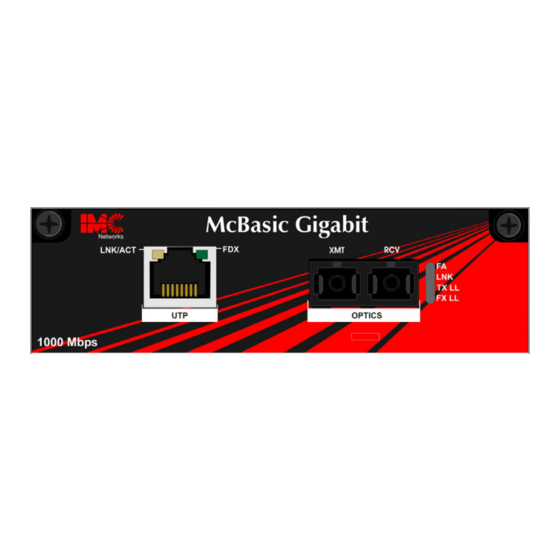Table of Contents
Advertisement
Quick Links
Advertisement
Table of Contents

Subscribe to Our Youtube Channel
Summary of Contents for IMC Networks McBasic-Gigabit
- Page 1 McBasic-Gigabit Operation Manual...
-
Page 2: Fcc Radio Frequency Interference Statement
At its option, IMC Networks will repair or replace at no charge the product which proves to be defective within such warranty period. This limited warranty shall not apply if the IMC Networks product has been damaged by unreasonable use, accident, negligence, service or modification by anyone other than an authorized IMC Networks Service Technician or by any other causes unrelated to defective materials or workmanship. -
Page 3: Table Of Contents
Table of Contents FCC Radio Frequency Interference Statement ...ii Warranty...ii About the McBasic-Gigabit...1 Configuration Instructions ...1 LinkLoss, FiberAlert and Link Fault Pass-Through...2 FX LinkLoss (FXLL)...2 Using FiberAlert and LinkLoss...3 Link Fault Pass-Through (LFPT)...4 Additional Gigabit Features ...5 Preferred/Forced Mode ...5 Installing a McBasic-Gigabit...6... -
Page 4: About The Mcbasic-Gigabit
McBasic-Gigabit has user-configurable features located on the PCB board. Please refer to the board diagram and the table for available features. To access the McBasic-Gigabit board for configuration, loosen the two screws on the front of the unit. Slide the board out of the enclosure (faceplate is attached). -
Page 5: Linkloss, Fiberalert And Link Fault Pass-Through
The appropriate “LNK” (link) LED is lit to indicate this. The IMC Networks media converter also sends out link pulses from its copper and fiber transmitters, but normally has no way of knowing whether the cable to the other device is intact and the link pulses are reaching the other end. -
Page 6: Using Fiberalert And Linkloss
TX LinkLoss (TXLL) TX LinkLoss is a troubleshooting feature. When a fault occurs on the twisted pair segment of a conversion, TX LinkLoss detects the fault and passes this information to the fiber segment. If a media converter is not receiving a twisted pair link, TX LinkLoss disables the transmitter on the media converter's fiber port. -
Page 7: Link Fault Pass-Through (Lfpt)
Link Fault Pass-Through (LFPT) is a troubleshooting feature that combines TX and FX LinkLoss from both the local and remote McBasic-Gigabit modules. LFPT is enabled by turning on both FX and TX LinkLoss on both modules. This feature allows either end of the conversion to detect a link fault occurring at the other end of the media conversion chain. -
Page 8: Additional Gigabit Features
If the device being connected to the McBasic-Gigabit module does not support Auto-Negotiation, disabling the feature on the McBasic-Gigabit module forces the link up. DIP Switch settings for FX AN: DIP Switch... -
Page 9: Installing A Mcbasic-Gigabit
Installing a McBasic-Gigabit To install McBasic-Gigabit, first make sure that the unit is placed on a suitable flat surface. Attach the cables between the McBasic Gigabit and each device that will be interconnected and then plug the unit into a reliable, filtered power source. -
Page 10: Led Operation
LED Operation Each McBasic-Gigabit Converter features diagnostic LEDs that provide information on features and ports. Glows green when a twisted pair link is established. Blinks green when data is LNK/ACT detected on the port. Located on RJ-45 connector. Glows amber when port is operating in Full-Duplex Mode on the RJ-45 connector. -
Page 11: Installation Troubleshooting
If this is the case, an optical attenuator may need to be added to the connection. For fiber specifications, visit the IMC Networks Web site at: www.imcnetworks.com/adocs/fcs.asp or contact IMC Networks for more information. -
Page 12: Specifications
32° - 122° F (0° - 50° C) Storage Temperature 130° - 158° F (-25° - 85° C) Humidity: 5 - 95% (non-condensing) Power Consumption (Typical) McBasic-Gigabit w/LFPT: 100 – 240V AC, 50/60Hz, 0.2/0.1A Fiber Optic Specifications For fiber optic specifications, please visit: http://www.imcnetworks.com/adocs/fcs.asp... -
Page 13: Imc Networks Technical Support
IMC Networks Technical Support Tel: (949) 465-3000 or (800) 624-1070 (in the U.S. and Canada); +32-16-550880 (Europe) Fax: (949) 465-3020 E-Mail: techsupport@imcnetworks.com Web: www.imcnetworks.com... -
Page 14: Fiber Optic Cleaning Guidelines
Dust caps are installed at IMC Networks to ensure factory-clean optical devices. These protective caps should not be removed until the moment of connecting the fiber cable to the device. Should it be necessary to disconnect the fiber device, reinstall the protective dust caps. -
Page 15: Safety Certifications
Electrical Equipment Designed for use within Certain Voltage Limits (73/23/EEC). Certified to Safety of Information Technology Equipment, Including Electrical Business Equipment. For further details, contact IMC Networks. Class 1 Laser product, Luokan 1 Laserlaite, Laser Klasse 1, Appareil A’Laser de Classe 1... - Page 16 The information in this document is subject to change without notice. IMC Networks assumes no responsibility for any errors that may appear in this document. McBasic-Gigabit is a trademark of IMC Networks. Other brands or product names may be trademarks and are the property of their respective companies.











Need help?
Do you have a question about the McBasic-Gigabit and is the answer not in the manual?
Questions and answers